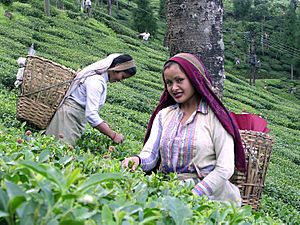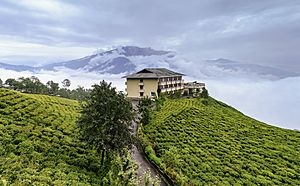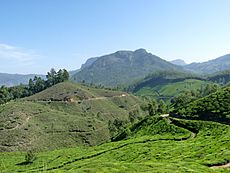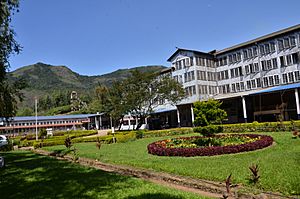History of tea in India facts for kids

India is one of the biggest tea producers in the world. Even though it makes a lot of tea, over 70% of it is enjoyed right there in India. Some very famous teas, like Assam and Darjeeling tea, only grow in India. The Indian tea industry has grown a lot. It now owns many global tea brands. It also uses some of the most advanced technology in the world. The Tea Board of India manages everything about tea in India. This includes making tea, checking its quality, and selling it to other countries.
Contents
The Story of Tea in India
For a long time, people in India used tea as a kind of medicine. In 1662, a traveler named Mendelslo wrote about how people drank "thay" (tea). They believed it helped clean the stomach and digest food. Later, in 1689, another traveler, Ovington, noted that people in Surat drank tea without sugar. They sometimes mixed it with lemons. Tea with spices was also used to help with headaches. The tea leaves for these uses likely came from China.
How Tea Plants Came to India
British colonists wanted to grow tea in India. They found that tea plants with thicker leaves grew naturally in Assam. When these plants were grown in other parts of India, they did very well. The Singpho people of Assam had been growing these same tea plants for a long time. They even supplied chests of tea to the British. Scientists now agree that the Assamese and Chinese tea plants are the same species, called Camellia sinensis.
In the early 1820s, the British East India Company started growing a lot of tea in Assam. This was the same type of tea the Singpho people traditionally drank. In 1826, the British took control of the Assam region. This happened through the Treaty of Yandabo. The first English tea garden opened in Chabua, Upper Assam, in 1837. Then, in 1840, the Assam Tea Company began selling tea from the region.
From the 1850s, the tea industry grew very quickly. Huge areas of land were turned into tea farms. By the early 1900s, Assam became the world's top tea-producing area.
Bringing Chinese Tea to India
Many people say that Robert Fortune brought Chinese tea plants to India. He spent about two and a half years in China, from 1848 to 1851. He was working for the Royal Horticultural Society in London. Fortune found ways to get tea plants and seeds, which were owned by the Chinese empire. He used special portable greenhouses called Wardian cases to keep the plants alive.
Using these small greenhouses, Fortune brought 20,000 tea plants and seeds to the Darjeeling region of India. This area has steep hills in the Himalayas and acid soil, which Camellia plants like. He also brought Chinese tea workers. These workers helped teach people how to grow and process tea leaves. Most of the Chinese tea plants Fortune brought did not survive. However, the skills and knowledge from China were very important. They helped the Indian tea industry grow, especially for Darjeeling tea, which still uses Chinese tea varieties.
Indian Tea Becomes Popular
Indian-grown tea quickly became very popular in Britain. People liked its stronger taste. They also liked that it was a product from the British Empire. When tea first arrived in Britain, it was a fancy drink. But its price slowly dropped, and it became popular with working-class people.
The Temperance movement in the 1800s strongly encouraged drinking tea. They saw it as a good choice instead of beer. Drinking water was often unsafe, but boiling water for tea made it safe. Many people, especially men, found Chinese tea too weak. They preferred the stronger, cheaper Indian teas.
By the late 1800s, big brands like Lyons and Liptons sold most of the tea. Tea was the main drink for everyone during the Victorian era. Working-class families often spent money on tea even if they had less for other foods. This meant there was a huge market for Indian teas. Soon, Indian tea (including Ceylon tea from Sri Lanka) became the usual kind of tea. Chinese tea became a less common choice. Until the 1970s, Indian tea was almost the only hot drink people bought. Its main competitors were cocoa and coffee. In recent years, Asian tea has lost some sales in Europe to tea from Africa, especially Kenyan tea.
Tea Production Today in India


India is currently the top producer of tea in the world. It has held this position for a long time. Indian tea companies have bought many well-known foreign tea businesses. These include British brands like Tetley and Typhoo.
In 2018, Camellia PLC became the world's largest private tea producer. This company owns the Indian tea giant Goodricke Group. They produced 103 million kilograms of tea that year.
Green tea is becoming very popular in India. In 2013, the amount of green tea consumed in India was growing by over 50% each year.
The main states in India that produce tea are:
- Assam
- West Bengal
- Tamil Nadu
- Tripura
- Arunachal Pradesh
- Karnataka
- Sikkim
- Nagaland
- Uttarakhand
- Manipur
- Mizoram
- Meghalaya
A Special Time Zone for Tea Gardens
Tea gardens in Assam do not use the Indian Standard Time (IST). IST is the time used across most of India and Sri Lanka. The local time in Assam's tea gardens is called "Tea Garden Time" or Bagantime. It is one hour ahead of IST. The British introduced this system because the sun rises very early in this part of the country.
This system has helped tea garden workers be more productive. They can finish their work during daylight hours. Workers usually start at 9 a.m. (which is 8 a.m. IST) and finish by 5 p.m. (which is 4 p.m. IST). This time might change a little from one garden to another.
Filmmaker Jahnu Barua has been working to get a separate time zone for the whole north-east region of India.
Tea in Movies
- Sagina Mahato is a Bengali film from 1970. It was directed by Tapan Sinha. The movie is about workers' rights in tea plantations in Northeast India during the time of the British Raj.
- Paradesi (which means Vagabond in English) is an Indian Tamil drama film from 2013. It was written and directed by Bala. The movie is based on true events that happened before India's independence in the 1930s. It focuses on tea estates in southern India.





